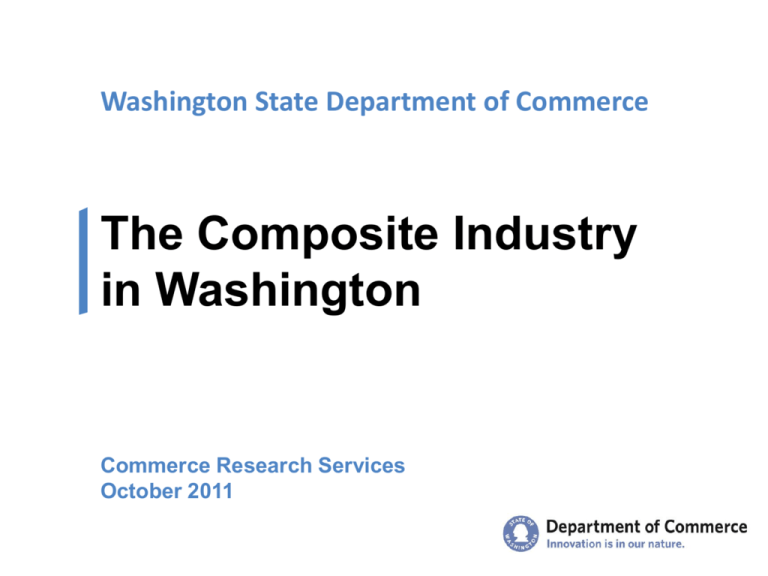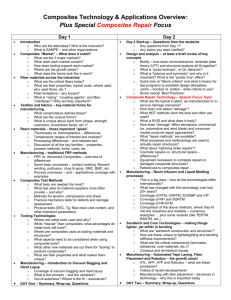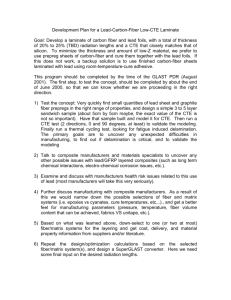Composite Industry in Washington
advertisement

Washington State Department of Commerce The Composite Industry in Washington Commerce Research Services October 2011 Research questions • What are carbon fiber composites, and why are they important? • What does the supply chain look like in Washington? • How does Washington compare to other domestic and international regions with carbon fiber activity? Project methodology • Phase One: o Descriptive, qualitative and quantitative research o A “snapshot” of the carbon fiber supply chain statewide • Phase Two: o Determine key comparators and inputs that support industry development o Compare Washington’s industry to other regions What are carbon fiber composite materials? Carbon fiber composites are the “new aluminum” • Aerospace, transportation, marine, wind energy, and recreation industries are committed to replacing aluminum with carbon fiber composites • Variable tensile strength and durability make composites highly customizable and useful in a variety of applications, including consumer products and biomedical devices Why is the carbon fiber industry important? Prospect of dramatic growth in the coming years Global composites market expected to reach $27.4 billion by 20161 • Low-cost labor countries will not dominate the industry; the quality of the finished product is most important • Jobs created will be high-value with many external multipliers Why is the carbon fiber industry important? Why is the composites industry important? Governor aims to make Washington the “Silicon Valley of Composites” • Position state as global leader in automobile, energy, and consumer composites • Diversify carbon fiber expertise gained through aerospace and Boeing’s 787 project Carbon fiber leaders in Washington Washington’s carbon fiber supply chain The Dept. of Commerce has identified over 80 carbon fiber supply chain locations in Washington3 • 53 composite supply-chain companies headquartered in state • 13 foreign companies with in-state operations at 17 locations • 1 major precursor manufacturer: SGL Group • • 31 composite manufacturers at 70 locations, including: o Hexcel, Saint-Gobain, Toray, Triumph 50+ composite fabrication companies at 70 locations, including: o AIM Aerospace, C&D Zodiac, Fokker Aerostructures Washington’s carbon fiber supply chain • • 25 input manufacturers and 31 input distributors at 65 locations: o American Autoclave Company, Aronson-Campbell Industrial Supply, Composites One, Janicki, Heatcon 24 supply-chain locations employ fewer than 50 workers Primary industries served: • 40 locations involved in aerospace composites • 20 locations focus on defense • 15 locations serve the automotive, energy, and recreation industries Washington’s carbon fiber supply chain Industries Served as Percentage of In-State Operations Aerospace Defense Automotive Recreation Marine Energy Industrial Tooling Consumer Medical Agriculture 0% 5% 10% 15% 20% 25% 30% 35% 40% Washington’s carbon fiber supply chain: Revenue data Initial revenue estimates4 • Aggregate gross business revenue increased by over 11% from 2009 to 2010 o 2009 revenue: $2.98 billion o 2010 revenue: $3.32 billion o 72 of 80 locations included in estimates o Estimates do not include Boeing or SGL Washington’s carbon fiber supply chain: Revenue data Washington Composite Companies Aggregate Gross Business Revenue in Billions of Dollars 2000-20104 5 4 $3,317,087,303 3 2 1 $999,950,492 0 2000 2001 2002 2003 2004 2005 2006 2007 2008 2009 2010 Washington’s carbon fiber supply chain: Employment data Initial employment estimates5 • Employment decreased by almost 7% from 2009 to 2010 o 2009 employment: 8,494 o 2010 employment: 7,940 o 69 companies out of 84 UBIs included in estimates o Estimates do not include Boeing and SGL; SGL’s Moses Lake facility will employ more than 200 workers at full capacity How are composites manufactured? Generally, carbon fiber manufacturing includes five stages: 1. Precursor preparation 2. Spinning/stabilizing fibers and producing yarn 3. Weaving fabric 4. Pre-impregnating the fabric (prepreg) 5. Fabrication and the composite part: autoclave molding, vacuum bag molding (resin infusion), press molding or pultrusion How are composites manufactured? The precursor Raw material is made into long, thin strands under .01mm in diameter • Derived from polyacrylonitrile (PAN), cellulose, petroleum or tar pitch, phenolics, and rayon • 39,280 tons produced globally in 2010 • Global demand will increase to 89,000 tons in 2015 and 134,000 tons in 2019 • Wind energy industry demand will almost quadruple to nearly 38,000 tons in 20156 How are composites manufactured? The precursor Precursor processing is the most energy-intensive component of the carbon fiber supply chain: • Energy accounts for one-third of the manufacturing cost for low-grade fiber and increases with high-grade fiber • Total production costs can reach $7.88 per pound of high-grade fiber6 Process uses heat: • Oxidative stabilization heats fibers to 572° F • Carbonization process heats fibers to 1300°to 1600° F • Final processing can use heat as high as 4500° F7 How are composites manufactured? The yarn Several thousand strands are twisted together to form yarn • Used in prepregs, filament winding, pultrusion, weaving, and braiding • Rated by linear density (weight by unit length) or number of filaments per yard count • Some carbon fiber yarns can tolerate over 750,000 PSI (pounds per square inch) before failure How are composites manufactured? Weaving and the prepreg fabric Yarn is woven into fabric and combined (impregnated) with resins and additives to form prepreg fabric • Carbon fiber can be combined with glass fibers, Kevlar,™ nylon, and polyester • Prepreg is ready to fabricate • Due to heat sensitivity, prepregs based on thermoset require refrigerated transportation and storage facilities How are composites manufactured? The composite part Prepreg is molded into shape to form composite parts Prepreg fabric can be fabricated in a variety of ways, including (but not limited to): • Autoclave molding • Resin infusion • Press molding • Pultrusion How are composites manufactured? Autoclave molding Used to manufacture large parts requiring strong material with minimal air bubbles (voids) 1. Layers of prepreg fabric are placed into molds 2. Molds are vacuum bagged and placed in an autoclave 3. Elevated pressure and temperature in autoclave cures composite material8 How are composites manufactured? Resin infusion Used to fabricate large or irregular parts Design modifications can be made quickly and economically 1. Prepreg fabric is placed into two-sided molds 2. Molds are placed in a vinyl or polyurethane bag and resins are injected 3. Vacuum is applied to shape material and eliminate voids How are composites manufactured? Press molding High-volume production of flat or moderately curved parts 1. Carbon fibers are injected with resins, and formed into shape with a heated press 2. Composite part is cooled How are composites manufactured? Pultrusion Used to fabricate tubes and rods Most efficient fabrication process; almost entirely automated 80-90% of the cost is materials High quality and low scrap 1. Yarn is pulled through thermosetting resins and fillers 2. Material is pulled through a shaped die, cured, and cut to desired length9 What does the supply chain look like? The supply chain can be thought of as “buckets” 1. Raw materials manufacturers, processors, and distributors 2. Inputs / machinery manufacturers and distributors 3. Composites and prepreg manufacturers and distributors 4. Composites fabricators and parts manufacturers 5. Research institutions, workforce training, and trade associations 6. Original equipment manufacturers (OEMs) 7. End users 8. Waste disposal and recycling Recycling Facilities Raw Materials Examples Operational: Precursor Processing – The Basics OEMs: Acrylonitrile powders Recycled Carbon Fibre Ltd.,plastic Coseley, UK 1. Spinning: Acrylonitrile powder is mixed with Composite Fabrication: Mitsui Kinzoku, Omuta City, Japan another plasticMethyl like methyl acrylate and the OEMs manufacture original equipment ACMAAmerican Composite acrylate Composites Manufacturer: plasticspecific is spun into fibers using composite materials. Manufacturers Association These companies make End-Users: parts for end-users or OEMs, though Potential: Methyl methacrylate they do not manufacture composite fabrics or original equipment Combine processed raw materials with Key Machineryprepreg and Supplies for Composites: 2. Stabilizing: Fibers are chemically altered to be Some OEMs manufacture their own http://www.acmanet.org/ These are the additives people, companies, and Adherent Technologies, proprietary Albuquerque, NW to make prepreg more thermally prepreg, and for many fabricate their own stable Nitric acid Methods fabrication: that use carbon Firebird Advancedinstitutions Materials, composite Raleigh, fabrics NC fiber-based Autoclaves parts. Some OEMs use vacuum contracted Autoclave molding, products molding, every press day.molding, TheySC include thermal airlines, Materials Innovation bag Technologies, Lake City, 3.inCarbonizing: Fibers are teachers, exposed to high heat, companies specializing composite Sodium hypocholorite expansion, and pultrusion doctors, golfers, tennis *Somenurses, composite manufacturers also Chemicals: Silicones, resins, adhesives without oxygen, to expel non-carbon atoms fabrication to manufacture their parts. players, hikers, kayakers, chefs, Recycling fabricate R&D: parts, though not all police fabrication Coating materials: epoxy, nylon, polyester, urethane officers, artists and musicians, governments, companies manufacture their own prepreg Tooling and fabrication equipment: robotics, 4. span Treating: Surface is slightly oxidized to OEMs using composites nearly every computer users, bus and drivers…everybody! Aircraft Fleet Recycling composites Association, cutting devices, vacuum devices, molds mold improve bonding qualities industry: aerospace, agriculture, Boeing, agents, Hexcel,mechanical Mitsubishi, Toho Tenax, Toray release presses automotive, consumer goods, defense, 5. Sizing:marine, Fibers are coated to protect from energy, industrial applications, Finishing products: paints, pigments, sanding damage medicine, recreation, and more!during winding or weaving products Supply chain vertical integration Janicki Industries, Inc. Sedro-Woolley SGL Group University of Washington: – multiple locations Moses Lake, Vancouver AutomobiliBoeing Lamborghini Advanced Composite Structures Hexcel • Designs and builds precision tooling for Heatcon Composite Systems Laboratory,aerospace, Burlington Kent marine, and wind energy and Tukwila Christensen Shipyards Vancouver • Leading producer of carbon fiber Center for Advanced Materials in Transport Aircraft Structures Electroimpact transportation industries precursor Mukilteo • One of the world’s leading composites • Heat blankets, autoclaves, curing Clover Park Technical College Insitu - Bingen manufacturers • Provides state-of-the-art engineering systems, and tooldue kits forskilled composite • Located in WA to labor and • Manufacturer of factory services, project management, and composite Edmonds Community- Anacortes College manufacturing and power repair James Betts Enterprises hydroelectric automation and tooling • Prepregs, reinforcements, molding fabrication solutions for aerospace compounds, honeycomb, tooling Everett Community College • Adhesives, resins, prepregs, Nolimitz Windsurfing – White Salmon • adhesives, Polyacrylonitrile (PAN) produced with materials, and carbon fiber • R&D lab explores new composite fabrication primers, andRayon release for Mitsubishi in agents Otake, Japan National Resource Center for Materials Technology Education • Designs automated fiber materials and techniques composite repair RainSong Graphite Guitars - Woodinville placement systems,space post • Serves commercial aerospace, Olympic College • PAN material turned processed into riveting systems, automatic and defense, wind energy, and •Composite repair courses Westport Shipyards – Westport carbon fiber training in Moses drilling machinery, andLake industrial applications Peninsula College offered globally assorted jigs and robotics • Carbon fibers processed in Landshut, Western Washington University Germany for use in the assembly of BMW’s Megacity vehicle Washington State University: School of Mechanical and Materials Engineering Key comparators: Washington’s competitive advantages • Education and workforce: Workforce development supported by an extensive network of universities, community colleges, and technical colleges offering materials technology programs. Large regional institutions researching materials technology. • Energy: Nation’s leading hydroelectric power producer. Lowest industrial electricity prices in the nation: $0.022 - $0.042 per kilowatt hour depending on location.10, 11 • Industry presence: Aerospace, biomedicine, and marine industry clusters • Infrastructure: Extensive air, water, railway, and road infrastructure Education: Washington’s assets12 State Higher Education Institutions Population w/HS Diploma Population w/Bachelor’s Degree Population w/Graduate Degree Washington 78 89.3% 30.3% 10.8% Alabama 72 81.9% 22.0% 7.7% Michigan 106 88.1% 24.7% 9.4% North Carolina 133 83.0% 25.6% 8.6% Utah 38 90.2% 28.7% 9.1% United States 66 (Median) 84.5% 27.5% 10.1% Education: Washington’s assets US NEWS TOP MATERIALS SCIENCE GRADUATE PROGRAMS13 Rank 1. 2. (Tie) 4. (Tie) School Massachusetts Institute of Technology Northwestern University University of Illinois– Urbana-Champaign University of California– Berkeley University of California– Santa Barbara Score 4.8 4.6 4.6 4.5 4.5 Rankings Among Comparator States 9. 22. 26. 42. 46. 52. (Tie) University of Michigan– Ann Arbor North Carolina State University University of Washington Michigan Technological University Michigan State University University of Utah Washington State University 4.2 3.3 3.2 2.7 2.6 2.5 2.5 Education: Washington’s assets PUBLIC UNIVERSITIES University of Washington • BS: Aeronautical and Astronautical Engineering, Industrial Engineering • MS: Aeronautics and Astronautics, Aerospace, Industrial Engineering • PhD: Materials Science & Engineering, Industrial Engineering, Mechanical Engineering • Automobili Lamborghini Advanced Composites Structures Laboratory Washington State University • BS: Materials Science & Engineering, Mechanical Engineering • MS: Materials Science & Engineering, Mechanical Engineering • PhD: Materials Science & Engineering, Engineering Science, Molecular Bioscience Western Washington University • BS: Plastics Engineering Technology, Manufacturing Engineering Technology Education: Washington’s assets PUBLIC COMMUNITY & TECHNICAL COLLEGES Clover Park Technical College • Certificates: Aerospace Composite Technician, Machinist Apprentice • AAT-T: Manufacturing Technologies • AAS-T: Material Science – Composites, Nondestructive Testing Edmonds Community College • Certificates: Materials Science Technology • AAS-T: Materials Science Technology • ATA: Manufacturing & Materials Technology Everett Community College • ATA: Advanced Manufacturing — Composites, Aviation Maintenance Education: Washington’s assets PUBLIC COMMUNITY & TECHNICAL COLLEGES Olympic College • Certificate: Manufacturing Technology • AS: Materials Science Engineering, Aeronautical Engineering, Industrial Engineering Peninsula College • Certificate: Composite Structures • AAS-T: Composite Structures Energy – How Washington Compares14 Average Retail Price of Industrial Electricity to Ultimate End-User, 2011 Average Retail Price of Industrial Natural Gas, 2011 3.85 ¢ / kWh $9.40 / 1,000 ft2 Alabama 5.85 ¢ $5.55 Michigan 7.35 ¢ $8.61 North Carolina 5.63 ¢ $7.19 Utah 4.68 ¢ $5.46 United States 6.58 ¢ $5.08 State Washington International Snapshot: China’s challenges The Chinese carbon fiber industry is developing slowly and faces significant obstacles to growth and expansion • • • Since the 1960’s, U.S. and European export controls prevented sharing carbon fiber technology with China due to national security and defense concerns. Lack of independent intellectual property rights makes it difficult for Chinese companies to import technology. Developing technology from “scratch” is costly. Most Chinese companies produce low-quality carbon fiber and cannot produce an equivalent to Toray’s lowest-grade T300 modulus.15 International Snapshot: China’s challenges China: Estimated Carbon Fiber Production and Demand in Tons, 201015, 16 10,000 9,000 9,000 8,000 7,000 6,000 Approximate import dependency ratio: 84 – 89% 5,000 4,000 3,000 2,000 1,000 1,000 100 0 Domestic Market Demand Domestic Production Average Manufacturer Production International Snapshot: Why Japan is competitive The Japanese carbon fiber industry is well-established, export-centric, and poised for continued growth. The country is home to world leaders Mitsubishi Rayon Co., Toho Tenax, and Toray Industries • Japanese manufacturers shipped 16,028 tons of carbon fiber in 2010, a 66.2% increase from 2009. • Three Japanese companies – Mitsubishi Rayon, Toho Tenax, and Toray Industries – account for 50.8% of global carbon fiber production. • Japan’s carbon fiber export ratio has expanded continuously during the last two decades, from 57.2% in 1991 to 78.6% in 2010. • The industry is supported by the Japan Carbon Fiber Manufacturers Association, which is exploring new commercialization opportunities and promoting life-cycle assessment methods for reducing the industry’s environmental impact.17 International Snapshot: Why Japan is competitive Japan: Annual Carbon Fiber Shipments, in Tons17 Sources 1. Lucintel. 2011. Growth opportunities in global composites industry 2011-2016. February. Available online: http://www.lucintel.com/reports_details.aspx?RepId=RPT1007 2. Sloan, Jeff. 2011. Carbon fiber market: cautious optimism. High-Performance Composites. 1 March. 3. Washington State Department of Commerce: Research Services carbon fiber supply chain database. 4. Washington State Department of Revenue 5. Washington State Employment Security Department 6. Boswell, Clay. 2011. Carbon fiber picks up speed. ICIS Chemical Business. 30 May. 7. Warren, Dave and Cliff Eberle. US Department of Energy. 2009. Precursor and fiber evaluation. 8. Daniel, Isaac M. 2006. Autoclave molding process. Northwestern University School of Engineering. Available online: http://www.composites.northwestern.edu/research/processing/autoclave.htm 9. http://www.pultrusions.org 10. U.S. Energy Information Administration. 2011. Form EIA-826, monthly electric sales and revenue report with state distributions report. 11. Grant County Public Utility District. 2011. Rate schedule no. 15 – large industrial service. Available online: http://gcpud.org/customerService/rateSchedules/Rate%20Sch%2015.pdf Sources 1. U.S. Census Bureau 2. U.S. News. 2008. Materials: best engineering schools. 3. U.S. Energy Information Administration. Available online: http://www.eia.gov/cneaf/electricity/epm/table5_6_a.html 4. ReportLinker. 6 Sept. 2010. Trend Analysis on Global Carbon Fiber Market. 5. Market Research News. 2011. Global and China carbon fiber industry report, 2009-2010. Available online: http://www.salisonline.org/market-research/global-and-china-carbon-fiber-industry-report2009-2010/ 6. Japan Carbon Fiber Manufacturers Association. 2011. Activities of the statistics working group (year 2010). Available online: http://www.carbonfiber.gr.jp/english/index.html






